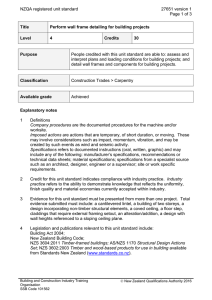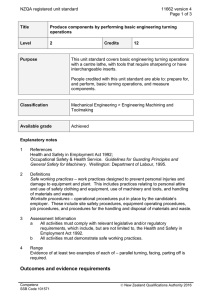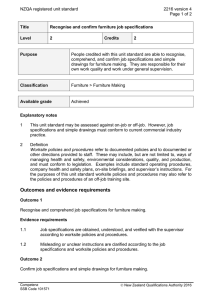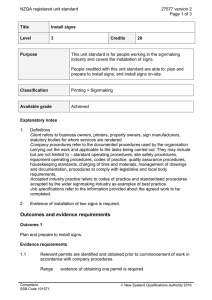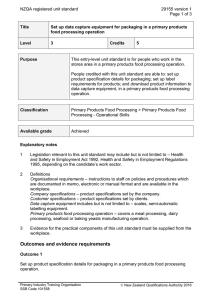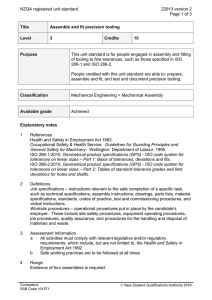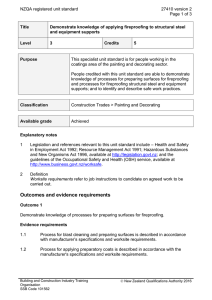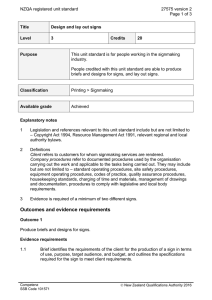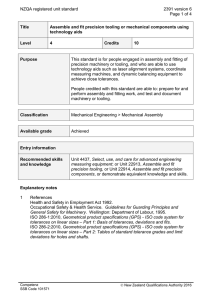NZQA registered unit standard 22914 version 2 Page 1 of 3
advertisement
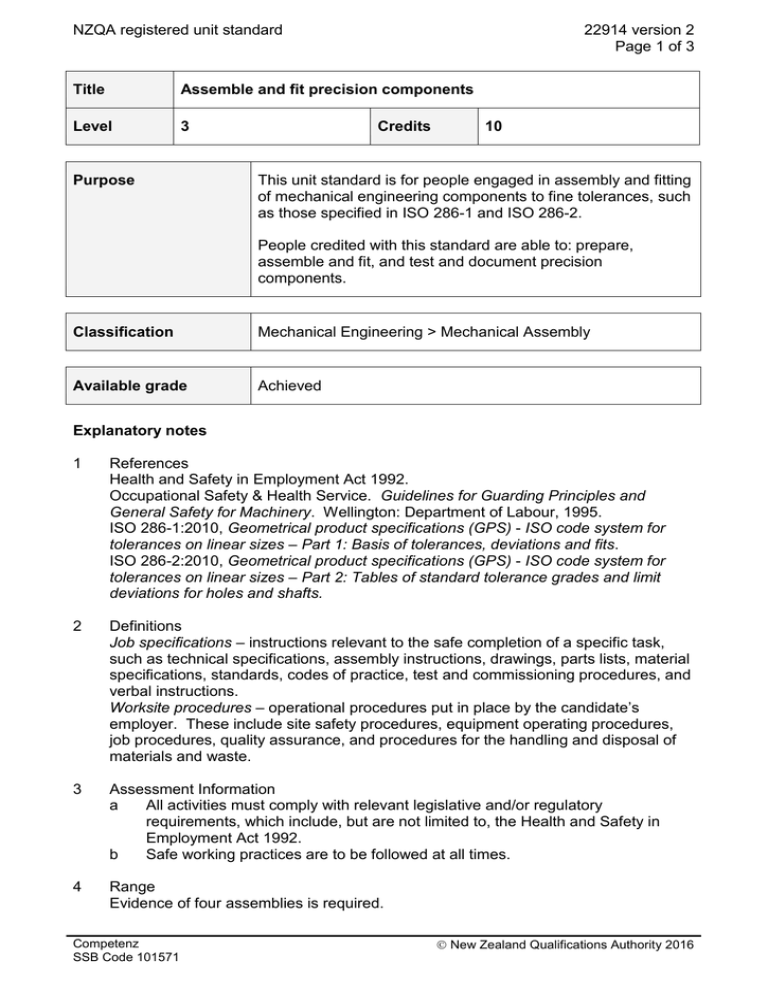
NZQA registered unit standard 22914 version 2 Page 1 of 3 Title Assemble and fit precision components Level 3 Purpose Credits 10 This unit standard is for people engaged in assembly and fitting of mechanical engineering components to fine tolerances, such as those specified in ISO 286-1 and ISO 286-2. People credited with this standard are able to: prepare, assemble and fit, and test and document precision components. Classification Mechanical Engineering > Mechanical Assembly Available grade Achieved Explanatory notes 1 References Health and Safety in Employment Act 1992. Occupational Safety & Health Service. Guidelines for Guarding Principles and General Safety for Machinery. Wellington: Department of Labour, 1995. ISO 286-1:2010, Geometrical product specifications (GPS) - ISO code system for tolerances on linear sizes – Part 1: Basis of tolerances, deviations and fits. ISO 286-2:2010, Geometrical product specifications (GPS) - ISO code system for tolerances on linear sizes – Part 2: Tables of standard tolerance grades and limit deviations for holes and shafts. 2 Definitions Job specifications – instructions relevant to the safe completion of a specific task, such as technical specifications, assembly instructions, drawings, parts lists, material specifications, standards, codes of practice, test and commissioning procedures, and verbal instructions. Worksite procedures – operational procedures put in place by the candidate’s employer. These include site safety procedures, equipment operating procedures, job procedures, quality assurance, and procedures for the handling and disposal of materials and waste. 3 Assessment Information a All activities must comply with relevant legislative and/or regulatory requirements, which include, but are not limited to, the Health and Safety in Employment Act 1992. b Safe working practices are to be followed at all times. 4 Range Evidence of four assemblies is required. Competenz SSB Code 101571 New Zealand Qualifications Authority 2016 NZQA registered unit standard 22914 version 2 Page 2 of 3 Outcomes and evidence requirements Outcome 1 Prepare to assemble and fit precision components. Evidence requirements 1.1 Job specifications are interpreted and task requirements determined. 1.2 Components are inspected and compared against inventory and job specifications, and any discrepancies rectified in accordance with worksite procedures. 1.3 Components are cleaned in accordance with job specifications and worksite procedures. Outcome 2 Assemble and fit precision components. Evidence requirements 2.1 Components are assembled and fitted in accordance with job specifications. 2.2 Seals are fitted and sealing agents are applied in accordance with job specifications. 2.3 Lubricants are applied in accordance with job specifications. Outcome 3 Test and document precision component assembly. Evidence requirements 3.1 Component assemblies are tested, and adjusted where necessary, to confirm conformance with job specification. 3.2 Performance of assemblies is documented in accordance with job specification and worksite procedures. 3.3 Assemblies are stored in accordance with worksite procedures. Replacement information Competenz SSB Code 101571 This unit standard and unit standard 22913 replaced unit standard 2388. New Zealand Qualifications Authority 2016 NZQA registered unit standard Planned review date 22914 version 2 Page 3 of 3 31 December 2014 Status information and last date for assessment for superseded versions Process Version Date Last Date for Assessment Registration 1 20 June 2006 N/A Rollover and Revision 2 17 November 2011 N/A Consent and Moderation Requirements (CMR) reference 0013 This CMR can be accessed at http://www.nzqa.govt.nz/framework/search/index.do. Please note Providers must be granted consent to assess against standards (accredited) by NZQA, before they can report credits from assessment against unit standards or deliver courses of study leading to that assessment. Industry Training Organisations must be granted consent to assess against standards by NZQA before they can register credits from assessment against unit standards. Providers and Industry Training Organisations, which have been granted consent and which are assessing against unit standards must engage with the moderation system that applies to those standards. Requirements for consent to assess and an outline of the moderation system that applies to this standard are outlined in the Consent and Moderation Requirements (CMR). The CMR also includes useful information about special requirements for organisations wishing to develop education and training programmes, such as minimum qualifications for tutors and assessors, and special resource requirements. Comments on this unit standard Please contact Competenz qualifications@competenz.org.nz if you wish to suggest changes to the content of this unit standard. Competenz SSB Code 101571 New Zealand Qualifications Authority 2016

